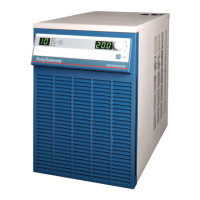12
Section 3 – Installation and Startup
WARNING: Be sure all power is off before proceeding.
3.1 Site Requirements
Ambient Temperature and Relative Humidity
The Chiller is designed for indoor installation in ambient temperatures between 5° and 30°C
(41° and 86°F); relative humidity should not exceed 80% (non-condensing).
Location
The Chiller should be installed on a strong, level surface. It should be located as close to possible to
the process requiring cooling. It should not be installed closer than 4 feet (1.4 meters) to a heat-
generating source, such as heating pipes, boilers, etc. If possible, the Chiller should be located near
a suitable drain to prevent flooding in the event of leaks. Do not place it where corrosive fumes,
excessive moisture, excessive dust, or high room temperatures are present.
For ease of positioning and maneuverability, the Chiller is supplied with casters. The front wheels
can be locked to keep the Chiller in place while in use.
To help prevent voltage drops, position the Chiller as close as possible to the power distribution
panel. Avoid voltage drops by using a properly grounded power outlet wired with 14 gauge or larger
diameter wire. The use of an extension cord is not recommended.
NOTE: The Chiller may be located at a level below that of the equipment being cooled. As long as
the process remains closed, overflow will not occur when adding cooling fluid to the Chiller reservoir.
Clearance
Adequate clearance should be allowed on the front, sides, and rear of the Chiller for access to
connections and components. The front and rear vents of the Chiller must be a minimum of 24
inches (61 cm) away from walls or vertical surfaces so air flow is not restricted.
3.2 Electrical Power
An IEC power cord is provided with the Chiller. It should be attached to the receptacle on the rear of
the enclosure. Make sure that the power outlet used for the Chiller is properly grounded and
matches the voltage and frequency indicated on the identification label on the back of the Chiller.
The use of an extension cord is not recommended. However, if one is necessary, it must be properly
grounded and capable of handling the total wattage of the unit. The extension cord must not cause
more than a 10% drop in voltage to the Chiller.
WARNING: DO NOT plug the Chiller into the electrical outlet until the
unit is ready for Startup (Section 3.7 below).
3.3 Optional Signal Inputs/Outputs
External Temperature Probe
This option allows you to control cooling fluid temperature using an external temperature
measurement (ambient room/machine temperature or process temperature). A 4-pin connector is
provided on the underside of the local control panel for connecting the external temperature probe.
NOTE: In order for the Chiller to properly recognize the presence of the external temperature probe,
the probe must be connected to the unit before power is applied.
RS232 / RS-485 Serial Output
This option allows you to remotely control the Chiller and/or output temperature readings to an
external recorder or other auxiliary device. The maximum communications distance for Chillers
equipped with the RS232 option is 50 feet (15 meters). The maximum distance for units equipped
with the RS485 option is 4000(1200 meters). A 9-pin D-connector is provided on the rear of the
instrument enclosure for this connection.

